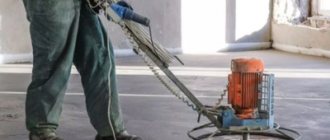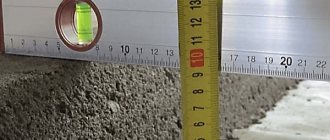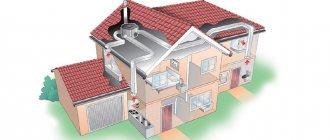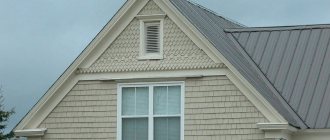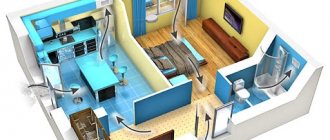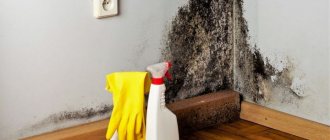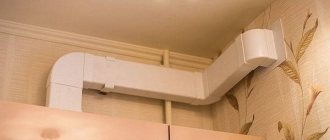In urban environments, people spend most of their time indoors. A lack of fresh air threatens a decrease in performance and a deterioration in well-being.
And if we add to this the constant presence of foreign odors, mustiness, dampness, mold in the corners? Knowing how to check the ventilation in an apartment will prevent you from taking the situation to an extreme.
We have described in detail all the practice-tested methods for testing the efficiency of ventilation systems. Here you will find useful information about the device and options for improving ventilation. The information is complemented by visual illustrations and video tutorials.
Reasons for lack of air flow
So, checking the draft showed that the ventilation passages are free, but the air in the apartment stagnates, the kitchen stench and, even worse, the toilet aroma do not disappear.
The thing is that the ventilation of most of our apartments was initially designed to allow fresh air to flow naturally through old wooden window and door structures due to the loose fit of the sashes and the presence of cracks.
Natural ventilation in an apartment: 1- air enters the room from the street, 2- flows from room to room, 3- goes into the ventilation duct. The performance of such a ventilation system depends on the time of year and weather.
And now completely different high-density building materials, various insulation materials, sealants, and plastic windows are used. We strive to make our homes warm with protection from outside noise and cold, but in the end we block our air flow.
Plastic windows and metal entrance doors clog the room so much that it turns into an airtight one.
Air does not pass through, there is no draft in the ventilation vents. It is especially bad in winter, when the windows are not opened even for ventilation, so as not to chill the rooms. But the problem is easy to solve.
It is enough to open the window a little, and air will begin to flow into the resulting gap. He will walk around the apartment and reach the ventilation holes, which are usually located in the kitchen and bathroom.
Unfortunately, in winter, if we ventilate our homes, it is in a different way. We open all the windows wide at once, but for a short time. At the same time, the air is completely renewed, the apartment does not have time to cool down, but the ventilation still does not work and will not work.
What about in the summer? It will not get better in the summer months, since in winter natural ventilation is forced to work by the difference in temperatures (internal and external), and when these temperatures equalize by summer, the movement of air flows stops.
Minimum consumption m3/h of outside air per person.
SP 60.13330.2016 “Heating, ventilation and air conditioning.”
View the full text of the document >>>
The table sets standards for people staying indoors for more than 2 hours continuously.
| Premises | Indoor air flow, m3/h | |
| with natural ventilation | without natural ventilation | |
| Public administrative buildings* | 40 | 60 20** |
| Residential with the total area of the apartment per person | ||
| — more than 20 m | 30*** | 45 |
| - less than 20 m | 3 m3/h per 1 m2 of living space | — |
| * The outdoor air standard is given for classrooms and offices in public administrative buildings. In other public premises, the standard of outside air should be taken according to the requirements of the relevant regulatory documents. ** For premises where people stay for no more than 2 hours continuously (cinemas, theaters, etc.). *** At least 0.35 air changes per hour, determined by the total volume of the apartment. | ||
Troubleshooting ventilation ducts
The first thing that comes to mind is clogged ventilation ducts. We remove the grille from the ventilation window and look into it. Garbage found within reach can be raked out manually or collected with a vacuum cleaner.
Removing garbage directly from the ventilation shaft is technically difficult, and this kind of independent action is prohibited for private individuals.
A ventilation shaft built of brick has an uneven inner edge; its clearance quickly becomes clogged and may even become completely covered with dirt. It is better if the trunk is made of smoother concrete blocks
If you suspect obstruction of the ventilation ducts, you should call specialists through the management company, who have the necessary diagnostic instruments and tools.
The found debris contains a lot of construction waste. Unscrupulous builders, when engaged in repairs and redevelopment, often deliberately dump rubbish into the ventilation shaft, without bothering to take it out into the yard.
The result is a blocked ventilation duct. The management company should also be involved in identifying such violations. But even without this, with each successive year of operation, dirt on the walls narrows the lumen of the ventilation duct, and the draft weakens. Dust settles in the ventilation system and cobwebs form. Leaves fly into the mine from above, and birds fall into it.
This is also facilitated by damage that occurs due to shrinkage of the foundation, cracking of walls and other consequences of the inevitable aging of the building. Clogged channels do not cope with the task.
Recommendations from experts
There are a number of customs among owners of residential buildings, commercial premises and apartments in MKDs that are erroneous. It is recommended not to take any actions aimed at trying to increase the efficiency of ventilation, because they can only lead to aggravation of the situation:
- You cannot climb onto the roof yourself to check the ventilation unit, because... It is not safe;
- Any actions of a person without knowledge can only contribute to a temporary improvement in ventilation, but not a complete solution to the problem;
- The lack of special instruments and knowledge of the design of ventilation systems makes it impossible to find the cause of the malfunction, without which a complete assessment of ventilation systems is impossible;
There are many publicly available methods that will definitely help you find out that the ventilation is faulty. After checking the effectiveness of ventilation and detecting poor performance, you should contact the management company or specialists who will assess its effectiveness and eliminate the malfunction efficiently and quickly.
Scheduled audit of ventilation of apartment buildings
Since the ventilation ducts are common to the house, their operation is ensured by the management organization, whose representatives are obliged to check the condition of the ventilation, and, if necessary, clean the shafts and repair them on the basis of a license or enter into the necessary agreements with specialized companies.
You can clear a blockage in the ventilation duct from the roof of the house if it is located at the level of the upper floors. At the lower levels it is often necessary to dismantle the shaft wall from the landings
The rules for checking ventilation provide answers to a lot of questions:
- how often are ventilation ducts checked?
- the presence of draft should be checked in apartments or it is enough to inspect only the ventilation shaft;
- Is the frequency of ventilation checks in bathrooms and kitchens the same?
- Is the management organization responsible or is the owner responsible for checking the draft in the apartment?
In apartment buildings, ventilation ducts are checked 1-2 times a year - this depends on whether there are gas appliances or whether only electricity is used. If gas is present, ventilation is checked twice - in summer and winter. If serious problems are identified, use of gas appliances is prohibited until they are corrected.
You cannot arbitrarily alter, repair, or improve ventilation in an apartment, since it is interconnected with the public system. All actions are coordinated with the relevant services.
Diagnostics
Carrying out diagnostics is a planned preventative procedure that allows you to prevent serious problems, the elimination of which will allow you to avoid costly repairs.
For diagnostics, professionals use instruments called anemometers, as well as video equipment that allows remote inspection and measurements.
Comprehensive diagnostics includes:
- measurement of the speed of movement of air masses;
- determination of system integrity;
- air exchange efficiency;
- survey of canals and mines;
- checking the network for trafficability (presence of congestion);
- drawing up a technical condition report.
Problems in the operation of a working system
It happens that ventilation works for a long time, remaining serviceable, and then suddenly stops or begins to blow air in the opposite direction. Indeed, if we discard all the reasons described above, it turns out that the problems with ventilation do not end there.
Let's look at how the natural ventilation of an apartment building with a vertical collection duct works.
The air enters the individual channel, rises parallel to the common shaft and enters it through the opening on the next floor, not reaching the plug separating the next individual channel belonging to the upper apartment
The main ventilation shaft leads from the first floor to the attic. All apartments are equipped with individual ventilation ducts (sleeves or satellite channels).
Each of them rises up one floor from the ventilation vent in a particular apartment and is inserted into the main duct slightly below the same individual ventilation duct belonging to the apartment on the floor above.
The air from the apartment moves through a satellite channel into a common shaft and there it moves further to the attic, and from there to the street. These satellite channels feed the general flow, and if air stops flowing through them, its volume and speed of movement through the main shaft will also decrease.
A hose that stops functioning in one apartment will not disable all ventilation along the riser in a 5, 9, or 16-story building. But the more apartments fall out of the general ventilation system, the weaker it is. Having reached a critical limit, the ventilation fails: the air flow reaching the attic level is so weak that it cannot push itself further.
Moreover, it goes down, and the channels-sleeves of the last two floors are the first to pull it back. To protect the upper floors from reverse draft, individual channels lead directly to the roof. But it is necessary to find out why the flow of air into the ventilation shaft is reduced in individual apartments.
Next to the common shaft there are individual ventilation ducts for the kitchen and bathroom. At the level of each floor they have access to a common shaft and are blocked with plugs
Let's consider a two- or three-room dwelling in which the kitchen and bathroom/toilet are separated at different ends, and therefore two independent ventilation ducts are built. One serves the kitchen, and the other serves the bathroom. This pair of channels pulls stale air from the apartment into the ventilation system, replacing it with fresh air.
Only the air flow from outside is considered correct. The widespread replacement of poor but breathable wooden window frames with double-glazed windows disrupts the circulation process. They do not allow air to pass through; temporarily opening windows for ventilation does not help, since for ventilation to occur, the air flow must be constant.
If the front door does not close so tightly, air may come from the staircase. It is no better in quality than what is in the apartment, but it maintains the viability of ventilation. Although, is there a need for a ventilation system in which the air in the house moves - with the smell of tobacco (they often smoke in the entrance hall), etc.?
When there is no internal air flow through the front door, one of the two ventilation ducts in the apartment (with a stronger draft) will begin to draw air from the second duct. Those. the draft in one ventilation duct is reversed at the expense of the other. The effect is the same - foreign exhaust air in the apartment, a lot of unwanted odors and aromas.
Fire
checking ventilation with fire
You need to use a lighter or a candle, a match. If you have gas equipment in your home, special care is required.
The sequence of actions differs from the previous situation:
- They light what they have chosen for testing.
- The device is brought to the vent so that the distance between it and the flame is 6-7 cm.
- If the fire deviates slightly, no more than 45 degrees, then everything is fine, there are no problems with the ventilation.
The vagaries of ventilation on the highest floors
In addition to the vertical outlet of the ventilation shaft to the outside, there are other engineering designs of the ventilation system - with a horizontal connecting box in the attic, which has a single exit to the roof, and with a large intermediate ventilation storage compartment, which serves as the attic itself, from where the air moves out through a single common ventilation shaft .
In many residential apartment buildings, one of these two ventilation schemes is found - with a horizontal collection duct (left) or with a warm attic (right)
In order for ventilation in apartments on the upper floors to work normally, the air must pass up the vertical shaft at least a few meters, but the attic serves as an obstacle to this, and the following happens:
- in a scheme with a horizontal box , air from all floors reaches the attic level and meets the ceiling of this box along the way. Without turning horizontally, he strives to find other passages, and these often become nearby ventilation hoses of the upper floors;
- in a scheme with access to the attic - in the satellite channels of the upper floors, the air flow does not accelerate enough to flow into the volumetric attic, and the air exchange in the apartments slows down.
In the first case, the ventilation is forced in the opposite direction, and all odors from the lower apartments penetrate to the residents above. Two solutions to the problem are to modernize the connection box, if technically feasible, or to separate the satellite channels of the upper floors from the box, insulate them and lead them directly into the shaft leading to the roof.
In the second case, the draft on the top floors is already weak, and if the attic is ventilated, it can also be reversed. Therefore, the length of the satellite channels on the upper floors is increased, brought to the attic higher and turned towards a common shaft so that the air flow from the lower floors carries with it weaker upper flows.
For rooms with gas boilers
Here the air volume reaches 100 m3 per hour. Many such premises require a natural type of ventilation. At the rate of three exchanges per hour, a hood is organized. The influx should work on the volume of the exhaust and the additional amount of air associated with combustion.
It is necessary to take into account the use of so-called heat generating equipment, which also affects the use of air flows.
It is necessary to at least inspect the ventilation grilles installed inside the apartment. This also helps to cope with unpleasant consequences, cravings are reduced.
Cleaning ventilation ducts
As for the main ventilation shaft, private individuals cannot touch it. File a complaint about poor ventilation with the management company and wait for specialists. Before their arrival, you need to notify your neighbors so that they can protect themselves from possible emissions of fine black dust from the ventilation grilles.
The classic way to clean ventilation ducts is with a brush. But it is confidently being replaced by modern methods based on the use of technology
Based on the results of the inspection of ventilation ducts, the commission issues a report with instructions for operation and repair.
During the examination, the cross-section of the channels and the length of narrowed areas are measured, paying attention to the condition of:
- shaft walls (cracks, etc.);
- connecting pipes;
- horizontal segments;
- air inlets, heads, hatches, etc.
To clean passages, industrial vacuum cleaners and mechanical devices with various attachments are used. The mine is illuminated by floodlights, and its interior is inspected using digital cameras and video cameras.
Repairing ventilation ducts does not require much time or expense. Destroyed sections of the channel are restored by installing metal or ceramic pipes inside, lining them with fastening solutions, and lining them with polymers.
The ventilation duct from the apartment to the common building shaft can and should be cleaned independently:
- move the furniture, remove unnecessary objects, move the stepladder to the wall;
- Below the ventilation hole, glue paper or newspaper to the wall with masking tape so as not to wash off dirt from the wallpaper or tiles, cover the floor;
- remove the decorative grille;
- Wearing gloves, carefully remove dirt and debris from the ventilation duct.
Remove any remaining dirt with a vacuum cleaner, replace the previously washed grille or replace the old one with a new one. After cleaning, check the traction again with the window slightly open.
Anemometer
checking ventilation with an anemometer
This is another method that differs from the previous two in maximum accuracy. An anemometer is a special device that measures the speed at which air flows.
The measurement technique in this case also does not involve a large number of actions:
- The device is brought to the vent. The exact distance is determined by the manufacturer depending on what type of model it is.
- The indicator is displayed and recorded.
- The volume of air passed through is calculated using the formula Q = V * S *360. V is an indicator of air flow speed. S – cross-sectional area of ventilation ducts, varies in m2.
25 m3/hour is a normal figure for bathrooms, in the case of a kitchen – 60 m3. The device just doesn't help detect odors.
Methods for optimizing ventilation in an apartment
If the ventilation in the apartment is disrupted due to the installation of sealed double-glazed windows, then use the ventilation mode. We are all familiar with summer ventilation - this is a completely open sash or its position at an angle due to the tilt-and-turn mechanism.
Winter mode is otherwise called micro-slot; to switch to this mode, you need to turn the window handle by 45º with the sash pressed.
In the winter ventilation mode, the gap formed between the sash and the frame is not visually noticeable, but the air seeping into it is quite enough to maintain ventilation
Another way out is to use supply ventilation valves. They are mounted in the external wall, in the joints filled with mounting foam between the window block and the wall, in the window profile, below the window sill.
In winter, there is a slight cold draft from the ventilation valves, but in the hot summer, air may not flow into them at all. Therefore, it makes sense to additionally equip the entrances to the ventilation ducts with exhaust fans.
In the bathroom you have to deal with high humidity. Moisture-proof fans built into the vents turn on automatically in response to rising humidity and turn off when the vapors evaporate and the air becomes drier.
In toilets, you can install a fan with a motion sensor and timer into the ventilation system. The fan automatically starts spinning when someone comes in and stops after a timer set. In the kitchen, fans with an air quality sensor that detect cigarette smoke and other unwanted odors will be beneficial.
The flow characteristics of the valves are different, there are models with adjustment, usually they install from two to four valves per apartment
And finally, about kitchen hoods. Their power is enough to allow a significant portion of the air in the apartment to pass through during operation. If there is not enough natural air flow, air will inevitably begin to flow back from the ventilation shaft of the bathroom. Limit the use of the hood and open the window slightly when you turn it on.
Paper
checking ventilation with a sheet of paper
This is the simplest method, the instructions for which are also not complicated:
- The paper strip is cut from any source that comes to hand. Width is within 2-3 cm, length – 15-20.
- The strip is brought to the vent connected to the ventilation system. Distance – minimum 5, but maximum 7 cm.
- Ventilation definitely works correctly if the prepared paper sheet is attracted to the vent, but is not completely drawn in.
